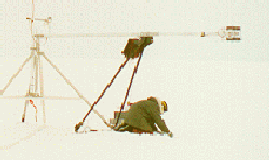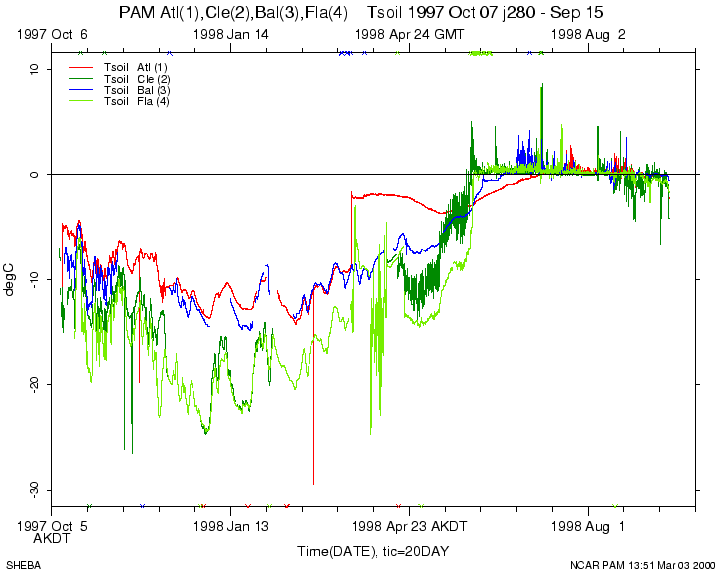
 SHEBA ISFF Flux-PAM
Project Report
SHEBA ISFF Flux-PAM
Project Report

 SHEBA ISFF Flux-PAM
Project Report
SHEBA ISFF Flux-PAM
Project Report
The temperature of the surface layer of the snow overlaying the sea ice and the heat flux between the snow layer and the sea ice were investigated using standard soil temperature probes and soil heat flux plates. The output of the sensors, Radiation Energy Balance Systems (REBS) models STP-1 and HFT-3.1, were input to the station Campbell CR10 data loggers, where the previously loaded calibration coefficients were applied. This calibrated data was then transmitted to the EVE data system.
The calibration of the temperature probes was undertaken in the NCAR Calibration Laboratory. The sensors, together with a reference Standard Platinum Resistance Thermometer (SPRT) traceable to NIST, were immersed to a depth of 25 cm in a Hart Scientific 7040 calibration oil bath. The SPRT was interfaced to a Hart Scientific Super Thermometer bridge and a Keithley 2100 DVM was used to measure the analog output signals. The data from the temperature probes, together with that from the SPRT reference, was archived on a laboratory PC. A temperature range of from 10 °C to -40 °C was covered. From 10 °C to -30 °C steps of 10 °C were imposed. Below -30 °C smaller steps were used. For each temperature a typical soak time of 2 hours was used to ensure stability and minimize any spatial gradients in the oil bath. The calibration accuracy for the temperature probes is ±0.05 °C.
Prior to resurrecting Station 2 on April 11, a new temperature probe was shipped from NCAR before a good laboratory calibration could be completed, so that the calibration coefficients in the Campbell data logger were only approximate. Then on August 11, the calibration coefficients in the Campbell data logger were changed to values thought to be more appropriate for that sensor. Thus, in order to correct the archived data to the post-project calibration of this sensor, linear corrections were made to the data as follows:
April 11 - August 11: Tnew = 0.9888 x Told - 2.42 August 11 - end: Tnew = 0.9964 x Told - 0.84
The calibration of the heat flux plates was undertaken by REBS, who state an accuracy of ±5%.
The transient nature of the sea-ice surface resulted in a more complex situation than that of the equivalent situation in soil, for which the sensors were designed.

|
| J. Militzer |
In addition to the comprehensive disturbance of the sub-surface sensors upon station reestablishment, other situations conspired to modify the sensors integrity within the sub-surface. The continual occurrence of wind and snow affected the nature of the exposed surface. Thus, the effect of deposition, erosion and ablation, all occurring at different times, continually altered the burial depth of the sensors and sometimes resulted in the exposure of the sensors. The underlying sea ice was in constant stress and, at times, leads and pressure ridges formed which interfered with measurements. The opening of a lead in the immediate vicinity of the Florida array on 14 March and again on 22 March resulted in breaks in the sub-surface sensor wiring. Even the local animals were assertive. Polar bear activity was the cause of damage to the sensors at the Cleveland site on 18 December and at the Maui site on 11 September.
However, the most persistent cause of sub-surface sensor disturbance during the SHEBA deployment was the effect of short-wave radiation penetrating the snow and being absorbed by the black bodies of the temperature probes and heat flux plates, causing them to warm. This not only yielded spurious data, but also generated local melting, causing the sensors to migrate and change orientation. This effect became important as summer conditions prevailed. As the intensity of sunshine increased, the snow/ice warmed to near melting. When radiation heating-caused migration occurred, the sensors would be found to reside at the end of a groove in the ice. Other causes of migration or realignment also ocurred, such as ice fracture, ablation and melt-water flooding.
It was in early July that the problem of migration became apparent. On 4 July it was noted at Florida that the heat flux plate had melted into the ice 12-15 cm and had tilted to vertical. The temperature probe had melted a hole 6-8 cm deep, which was full of melt-water. It was realized that the same situation could prevail at the other sites. On 6 July the temperature probe at Atlanta was found to be 20 cm below the surface, but there was no evidence of radiation heating. However on 6 July at Maui and on 9 July at Baltimore, evidence of radiation heating was evident. All the temperature probes and the heat flux plates were eventually retrieved, wrapped in aluminum foil and reburied. At Florida both probe and plate were wrapped on 5 July. At Maui both probe and plate were wrapped on 9 July. The probes at Baltimore and Atlanta were wrapped on 8 July, but there is some uncertainty as to when the corresponding plates were wrapped and reburied. By the middle of July all sub-surface sensor appear to have been wrapped in aluminum foil and reinstalled in the proper orientation at the snow-ice interface. This measure reduced the effect of radiation heating but did not prevent movement and tilting of the sensors. Indeed, the data suggest that diurnal radiative effects were persistent throughout the summer. From mid-July until the end of the SHEBA deployment, two and a half months later, melting of the surface and interchange of surface melt water and sea water rendered the conditions very complex, and the depths and orientations of the sub-surface probes became more and more uncertain. As can be deduced from the following observations, the movement and tilting of the sub-surface sensors continued. It can only be assumed that in every instance when the sensors were noted to be awry, they were subsequently properly reinstalled.
On 22 July the sensors at Atlanta were noted to be in water-filled cavities under the snow in tilted orientations. The probe was repositioned at this time and then again on 15 August. When the sensors were finally extracted at tear-down, on 1 October, they were found to have migrated further into the ice and to be tilted.
The Maui sensors also moved. On 10 August their aluminum foil was replaced and the sensors were repositioned. Because of the precarious location of Maui in the last months and the relocation of the tripod the sub-surface sensors were subjected to additional trauma.
On 22 July the Baltimore sensors needed to be repositioned. They had worked their way 6-7 cm into the ice and tilted to 45°. By 10 August the heat flux plate had again tilted to 30° and was 9 cm into the ice in a water-filled crevice. The temperature probe was 6 cm deep in a dry crevice. They were both repositioned again. When the station was decommissioned on September 21, both sensors were frozen deep in the ice. Since the sensors were abandoned, their final orientation is unknown.
On 19 July the Florida temperature probe needed to be repositioned. When the Florida radiometer array was leveled on 29 July, the sub-surface sensors were reinstalled. On 8 August the sensors were dug out from 8 cm of ice and reinstalled near the surface. When the station was decommissioned on 1 October both sensors were at the bottom of grooves extending from the top of the ice. The heat flux plate was canted to 30°.
Figure 8.1 shows the indicated snow/ice temperature at the four remote sites. The general trend of the temperature shows a broad minimum in mid-winter, from December to February, with a gradual increase, starting in March. As early as April, for Station 2, but then becoming apparent for the other stations, a diurnal temperature pattern becomes apparent. This may be due, in part, to the diurnal warming of the snow/ice, but probably is also an instrumental affect, caused by radiative heating of the probes. Wrapping the probes in aluminum foil was not completely effective. By the end of June, the influence of melt-water tends to bring all daily minimum temperatures to 0°C. The sub-surface temperature readings that exceed 0°C may be partially due to radiative heating of the probes. During the last month of the deployment the snow/ice temperature begin to decrease and the effect of melt-water decreases.

|
| Fig 8.1. The temperature of sub-surface snow at the four remote sites. |
The heat fluxes measured in the subsurface snow are plotted individually for Stations 1, 2, 3, and 4. Beginning with Station 2 in April, but then becoming apparent for the other stations, the affect of diurnal radiative heating becomes apparent. The aluminum foil wrapping in early July may have diminished the effect but did not eliminate it. During the summer, the plates tilted to different orientations and the measured heat flux becomes difficult to interpret. In September the traces begin to stabilize as the snow/ice begin to freeze again.
| Table of Contents | Previous | Top | Next |